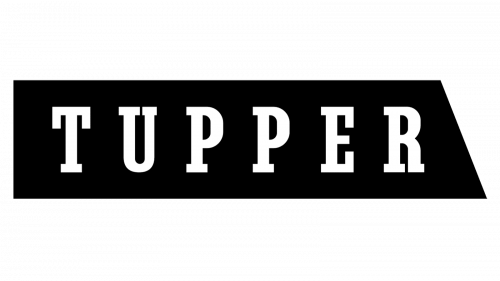Tupperware Logo
Tupperware, an iconic brand, primarily focuses on producing innovative, eco-friendly kitchen and home products, including food storage containers and cookware. With a global footprint, its chief markets encompass North America, Europe, and Asia-Pacific. The company thrives on a direct sales model, leveraging a vast network of independent representatives. Emphasizing sustainability and quality, Tupperware continually adapts to modern consumer needs while retaining its legacy of trust and durability.
Meaning and history
Tupperware’s story began in 1946, with the inventive mind of Earl Tupper, who introduced durable, airtight, plastic containers, revolutionizing food storage. Initially, the products were sold in stores, but sales were lukewarm. Everything changed in the early 1950s when Brownie Wise proposed the idea of Tupperware parties, transforming the sales model. This direct-sales approach skyrocketed the brand’s popularity, turning Tupperware parties into social events.
In the 1958, Earl Tupper sold Tupperware to Rexall, which later became Dart Industries. The company underwent further mergers, notably with Kraft Inc. in the 1980s, forming Dart & Kraft. Post separation in 1986, the company was renamed Premark International. In 1996, it merged with Illinois Tool Works. Yet, Tupperware stood out, becoming Tupperware Brands Corporation after demerging in 1996.
Throughout the years, Tupperware expanded globally, diversifying its product line and adapting to changing market needs. By the 21st century, the brand had a presence in over 100 countries, with Asia and Latin America being significant growth areas. The brand also evolved, emphasizing eco-friendliness and sustainability.
Ownership shifts and production adaptations have marked Tupperware’s journey. The company faced challenges, including adapting to online retail. However, it has always thrived, focusing on innovation and quality, all while retaining the essence of Earl Tupper’s pioneering vision.
1938 – 1946
The logo for Tupperware projects a sense of timeless professionalism and industry expertise. Crafted in a bold, black font, the name “TUPPER PLASTICS, INC.” spans across the entire design, immediately catching the viewer’s attention. The capitalized letters evoke strength and reliability, reinforcing the company’s established reputation in the plastics industry. Beneath the main title, the location “FARNUMSVILLE, MASS., U.S.A.” is gracefully incorporated, offering a nod to the company’s origin and grounding the logo with a sense of place. Overall, the minimalist black and white palette adds to the logo’s straightforwardness, suggesting transparency and trustworthiness. The simplistic design speaks to the company’s focus on product quality and dedication to its craft rather than relying on overly ornate visuals.
1946 – 1947
The oval-shaped “TUPPER” logo is a masterclass in brand recognition and simplicity. Encased within a sleek, black oval border, the name “TUPPER” stretches across its center, utilizing bold, elongated letters that provide an instant visual impact. The contours of the oval lend a sense of continuity and completeness, symbolizing the brand’s all-encompassing approach to quality and customer satisfaction. The stark contrast between the black background and white lettering creates an eye-catching dynamic, ensuring the logo remains memorable in the minds of its audience. The typography, with its strong vertical lines, gives a sense of stability and durability, mirroring the lasting quality of Tupper products. The design, while minimalist, conveys a message of sophistication, longevity, and reliability, attributes that have become synonymous with the Tupper name.
1947 – 1948
This logo is marked by its bold, uppercase presentation of the word “TUPPER.” The letters are uniformly spaced, bringing a sense of harmony and balance to the design. The typography is traditional, possibly hinting at the brand’s enduring legacy or a commitment to classical values. Each letter stands tall, conveying strength and assertiveness. The black color palette lends the design a certain timelessness, versatility, and sophistication.
1948
The Tupperware logo, used by the brand in 1948, featured a custom handwritten “Tupper Corporation” lettering in the uppercase of a modern sans-serif typeface, with the first “T” enlarged. The horizontal bar of the “T” was elongated to both sides, “roofing” the “U” and half of the “P”. This was a tribute to the main peculiarity of the Tupperware products — its lid.
1948 – 1949
This design is a more playful and dynamic take on the word “TUPPER!” The use of mixed case letters adds a youthful and modern flair, while the exclamation point at the end injects energy and enthusiasm into the brand’s persona. The ‘T’ and ‘R’ have been stylized with elongated horizontal strokes, giving a sense of motion and forward momentum. The typography is free-flowing, suggesting flexibility and adaptability. The black color maintains a sense of elegance and neutrality.
1949
The image presents a classic yet captivating wordmark: “Tupperware.” At first glance, the typography stands out with its elegant and fluid cursive script. The letterforms flow seamlessly into one another, reminiscent of handwritten calligraphy. The elongated curves of the letters, particularly the “T” and “w,” give the logo a distinctive and memorable appearance. The way these letters stretch and loop evokes a sense of sophistication and class. It’s clear that every stroke has been meticulously crafted, emphasizing both precision and creativity.
The choice of black as the sole color adds to the logo’s timeless appeal. Black is not only versatile, allowing the logo to be placed on various backgrounds and mediums, but it also carries connotations of elegance, authority, and stability. The absence of embellishments or additional graphics ensures that the focus remains squarely on the brand’s name, emphasizing its prominence in its industry.
Overall, the “Tupperware” logo effortlessly combines tradition with modernity. Its refined typography communicates both the brand’s heritage and its commitment to quality. While simple in its design, the logo leaves a lasting impression, speaking to the brand’s legacy and its continued relevance in today’s market.
1949 – 1978
In 1946, the brand’s initial logo graced the public eye, showcasing the company name in striking black cursive script against a stark white canvas. The typography was anything but conventional. Predominantly, it leaned towards a bold typeface devoid of any serifs. Amongst all the characters, the designer seemed particularly invested in the intricacies of the “T” and “W.” Notably, while each letter was presented in uppercase, the “T” dominated in size. Its horizontal stroke notably extended well beyond typical proportions. On the other hand, the “W” gave the illusion of being crafted by overlaying two “V” characters, lending it a unique duality. This initial design was not only a reflection of the brand’s name but also an artistic interpretation embodying its essence.
1978 – 1995
In 1978, Tupperware underwent a pivotal logo transformation. Instead of sticking with solid designs as before, the brand embraced a novel design aesthetic, featuring white, rounded contours and gentle shapes. These white delineations, juxtaposed against black boundaries, evoked a maze-like ambiance, capturing the viewer’s attention. Remarkably, this rendition stood the test of time, gracing the brand’s identity for over three decades. It wasn’t until the dawn of the new millennium that a fresh emblem took its place. Additionally, the reintroduction of the ® symbol affirmed Tupperware’s exclusive rights over this distinct branding, underlining its uniqueness in the corporate landscape. This design evolution not only marked the brand’s adaptability but also showcased its commitment to staying contemporary and relevant.
1994 – 2024
In 2007, Tupperware unveiled its latest logo iteration. Intriguingly, this version embraced a dual-color scheme: either a deep black or a vibrant fuchsia hue. Both colors contrast strikingly against a pristine white backdrop. Occasionally, the design is accompanied by a distinctive emblem positioned to its left. This emblem, taking its color cues from the logo—either black or pink—presents an abstract representation. Emanating from its core are lines, each adorned with a circle, collectively evoking the image of a dandelion in bloom. At a glance, this logo aims to convey a profound feeling of resilience and assurance, testament to the brand’s enduring legacy. Importantly, the signature ‘registered’ symbol remains, underscoring the brand’s proprietary claim over this emblematic design. This visual transformation reflects Tupperware’s commitment to modernity while preserving its iconic heritage.
2024 – Today
The redesign of 2024 has created a modern and unique Tupperware logo, which perfectly represents not only the power of the brand but also the famous lid of the Tupper containers, which brought popularity to the company’s products. The logotype doesn’t differ much from the previous version but is written in a more lightweight font, which makes the whole composition more airy and elegant.
Font and color
The playful yet stable lettering from the primary Tupperware logo is set in the title case of an elegant sans-serif typeface, which looks pretty similar to such fonts as Roc Grotesk, or BB Torsos Protrade, with some visible modifications.
Throughout the years since the day of the brand’s establishment, Tupperware has always been loyal to its minimalistic yet strong black-and-white color palette, which is synonymous with the high quality of the Tupper products and the stability of the company.





















